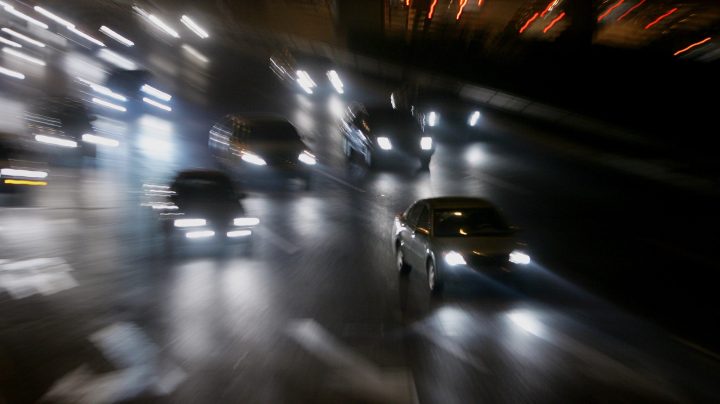
Adaptive headlights will soon make night driving brighter without blinding others
Adaptive headlights will soon make night driving brighter without blinding others

Headlight brightness can be a major nuisance while driving at night. They glare in the rearview mirror and blind drivers to oncoming traffic. However, a policy change from the National Highway Safety Administration in February will allow new technology following in the footsteps of European regulators.
Adaptive headlight technology can make night driving safer while also better illuminating the road.
“We know drivers don’t use their high beams enough,” said David Aylor, the vice president of active safety testing for the Insurance Institute for Highway Safety. “This would allow them to use their high beams again without glaring other vehicles around them.” Aylor spoke to “Marketplace” host Kai Ryssdal about the technology.
The following is an edited transcript of their conversation.
Kai Ryssdal: Tell me what these adaptive beam headlights are.
David Aylor: Yeah, so adaptive driving beam headlights, they use a forward-looking camera to detect the presence of other vehicles. And basically, when there are no other vehicles around, it’s like having your high beams on. But as soon as it sees other vehicles, whether you’re following a car or there’s a car coming towards you, it will actually sort of create a shadow in the area of that car. So you’ll have high beams everywhere else, except for where that car is. And the hope is that it limits glare to other vehicles around you.
Ryssdal: It’s been available in Europe, worked well over there. What’s taken America so long?
Aylor: Yeah, so you know, the federal standard for headlights really hasn’t changed since probably the ’70s. And and it requires both a low beam and a high beam. And unfortunately, because this new technology is sort of a mixture of the two, it hasn’t been allowed until earlier this year. And so, you know, it really was something that was encouraged by Congress for the federal government to actually write a rule that allows these type of systems.
Ryssdal: Is it going to be up to carmakers? And if so, I’m gonna get really — how to put this — cynical here. What’s, the cost factor gonna be if I want these fancy headlights on my new car?
Aylor: Yeah, so I think it’s probably going to just like other technologies. It’s going to start on higher-end cars, it may even start on the more expensive trims. And as we start to see the technology more often, it may trickle down into more streamlined cars. You know, most of the cars now have that camera for other technology and other purposes. I think they can do it. I should mention that I think one of the biggest challenges is because this is a new rule, and it’s different than what’s around in Europe, it will take the manufacturer some time to sort of figure out a type of system that will meet the new standard,
Ryssdal: What’s the “how much time,” and I ask as a guy in the market for a new car. So it’s going to be on a 2024 model?
Aylor: We may see some in ’24. My hunch is it’s probably going to be 2025 and later. And again, you know, it’s going to start on the higher-end vehicles or higher-end trim lines.
Ryssdal: I probably should have started with this, but it works, right? If you don’t have that guy flashing his brights in your face or coming up behind you with the high beams on, it’s going to be a safer driving experience.
Aylor: Yeah, well, we know we’ve done lots of work looking at headlights, and we know headlight visibility is important. A majority of crashes occur at night, or driving at night is more risky. And so visibility is important, but obviously limiting glare to other drivers. And so we know drivers don’t use their high beams enough. This would allow them to use their high beams again without glaring other vehicles around them. So yeah, it definitely has the potential, and so we’re encouraged that systems will be allowed in the U.S. market.
Ryssdal: Let’s say it costs $1,000. And you buy a new car and you want this. Would you personally — you’re a trained safety guy — would you put this on your car?
Aylor: Yeah, I think it’s something, again, that would be helpful. And the drivers sort of don’t have to think about switching between their low and high beams. So it is a technology I think that I would want on a new car.
There’s a lot happening in the world. Through it all, Marketplace is here for you.
You rely on Marketplace to break down the world’s events and tell you how it affects you in a fact-based, approachable way. We rely on your financial support to keep making that possible.
Your donation today powers the independent journalism that you rely on. For just $5/month, you can help sustain Marketplace so we can keep reporting on the things that matter to you.











